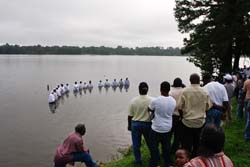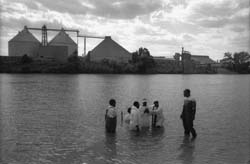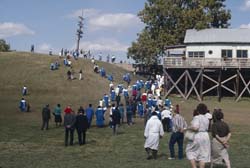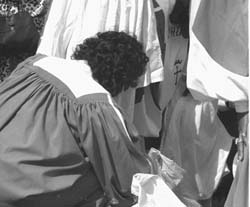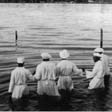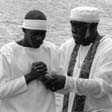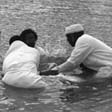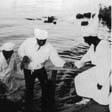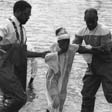Introduction to Delta Pieces: Northeast Louisiana Folklife
Map: Cultural Micro-Regions of the Delta, Northeast Louisiana

The Louisiana Delta: Land of Rivers








Ethnic Groups










Working in the Delta








Homemaking in the Delta




Worshiping in the Delta



Making Music in the Delta




Playing in the Delta







Telling Stories in the Delta



Delta Archival Materials
Bibliography

"Take Me to the Water": African American River Baptism
By Annie Staten and Susan Roach
In the Louisiana Delta region, lying between the Ouachita and Mississippi Rivers, African American Baptists still occasionally perform their sacred ritual of outdoor baptisms in rivers, bayous, and lakes. As late as the 1950s, outdoor baptism was common in both black and white Protestant churches in rural North Louisiana. Even though the majority of urban and modernized rural churches have indoor baptismal pools, some African American urban, along with older churches without indoor facilities, have chosen to maintain the earlier, natural setting for this important rite of passage, a symbolic ritual purification and initiation.
One such pastor, Rev. L. D. Oliver, of the St. Paul Baptist Church in Monroe, has reminded many area younger ministers about their heritage of river baptism, following the Biblical example of Christ's baptism in the Jordan River by John the Baptist, and has urged them to preserve this tradition. Consequently, for the past three years, Rev. Oliver and Rev. Roosevelt Wright, pastor of the Tabernacle Baptist Church, have gathered their congregations together for river baptism. For many years, the river baptizing was held by Rev. Oliver about once every five years, in order to keep the river ritual alive in the memories of children, but interest in preserving the heritage appears to have strengthened the frequency of the performance.
Baptisms were generally held during the summer or early fall so the water would be warm enough. Outdoor baptismal locations tend to be used traditionally in a community, with various churches using the same spot for generations. Churches in Rayville and Alto still go to the Beouf River, and in Lake Providence, the selected lake spot is near the Soldier's Rest historical marker-the area where General Grant's Civil War Black Union troops camped during their attempt to dig a canal to the Mississippi. In Monroe, the Ouachita River at the foot of Pine Street has been used for several generations and called by older community members "the old burying ground," an apt name for the ritual of baptism in which the candidate is symbolically buried in Christ, where sins are washed away, and one is raised up to "walk in newness of life." Usually the outdoor baptism follows the African American Baptist churches' annual revivals, which in the past in the plantation churches lasted two weeks. After a first week of prayer meetings, the second week featured preaching by the pastor or guest minister whose goal was to draw sinners to God. Today the revivals may last only a week. But still today those who accept God become waiting candidates for baptism. African American baptism follows the ritual model developed by anthropologist Arnold Van Gennep, who outlined three stages of such rites: (1) separation, where the initiates are dressed in ritual dress and set apart from the rest of the group; (2) transition or liminal, where they are between states; and (3) incorporation, where they are integrated into the group.
In preparation for the baptism, the "Mothers of the Church" must make or otherwise obtain the traditional robes to fit each candidate, although some churches such as St. Joe and St. Luke Baptist Churches may not use robes for the candidates. The actual design of the long flowing cotton gowns with long sleeves may vary slightly with the community, but most of them are sewn on machines from handed-down, traditional patterns cut from newspaper. Monroe churches' gowns have two narrow, torn strips of fabric tied around the gown-one around the waist and another below the knees, which function to keep the robe in place over the legs. Some believe that these ties represent the bonds of sin, and that after baptism, their removal signifies the freedom from sin and rebirth. Also headgear may vary; in some groups such as those in Lake Providence, a full hat resembling a small chef's hat is worn instead of a wide band over the forehead. Just before the service begins, the mothers help the candidates put on the robes usually over old clothes. The baptismal candidates are lined up, youngest first, by the church mothers. Before the baptisms actually begin, one or more of the church deacons wade out into the water with stakes to poke the water bottom for a safe spot where the water is not too deep, nor the bottom too boggy or dangerous; usually about waist-deep on a man is considered to be safe. After the safe location has been determined, the deacons push the three stakes into the river bottom, forming a safe arc for the ritual. While some churches do not use three stakes, others such as the Monroe churches do, which according to Rev. Roosevelt Wright, Jr., symbolize the Father, Son, and Holy Ghost.
When the stakes are in place, and members of the church congregation have gathered in excitement on the bank to witness the baptizing of a loved one, the service begins with the deacons leading the devotional consisting of singing of Dr. Watts hymns, scripture reading, and prayer.
The candidates are led to the water by two deacons while the minister (or ministers, if more than one congregation) assisted by deacons wade into the water while the congregation sings. The minister begins his part of the ritual by giving the meaning of baptism. Rev. L. D. Oliver began his September 1994 sermon with the following remarks: "We gather here on this old river here that drifts into the sea, because we have come back here. Things may have changed uptown; banks may have gone out; shopping centers may have closed, but this old river just keep on. So we thought the church would come back here and tell the Lord, we thank Him for this old river." Often the minister will refer to Biblical scripture that directs their ritual; the third chapter of Matthew, which tells the story of John the Baptist is a favorite.
After the opening sermon, the candidates are then escorted to the minister one by one. The minister folds the candidate's hands in prayer, and covers the candidate's face. As he baptizes each one, the minister repeats a ritual statement, which may vary with ministers: "I baptize this little sister [or brother and gives name] in the name of the Father, the Son, and the Holy Ghost on the belief of their faith," or "In obedience to the command of God, I baptize [gives name] in the name of the Father, in the name of the Son, in the name of the Holy Ghost." The candidate is immersed in the water. As each candidate is brought up out of the water, the congregation applauds and sings refrains from favorite baptismal songs such as "Take me to the Water," "I know I've Got Religion," and Dr. Watts hymns and moans. The services are generally spirit-filled, with many of the congregation becoming overwhelmed, singing, shouting praises, and shedding tears of joy as they watch their children being baptized.
When the baptized come out of the water, they are gathered up into waiting arms and covered in large sheets and towels to protect them from the air and then whisked away to dress, often in white Sunday clothes, behind sheet curtains up the riverbank; then they are brought back to witness the remaining baptisms. Between candidates, the minister will frequently give a short sermon, and often after the last candidate, the minister may go into a longer sermon. If more than one minister is participating, they may take turns. The ceremony closes with all the ministers and deacons walking back to the water's edge, where they hold hands in a closing prayer. The service usually ends with joyful singing in celebration of the new converts.
Frequently, the baptism is followed by a gathering at the church building for fellowship, the final incorporation stage of the rite. Upon returning to the church, the converts may still wear a white bandanna or handkerchief on their heads until they are fellowshipped into the church. In the past, it was typical for the pastor to read the church covenant and explain it to them and then present them as full, pledged members of the church. The shaking of the candidates' hands begun by the pastor, then followed by the deacons and the congregation, symbolizes that they are indeed members of the church, and the head gear is removed. Today several churches offer the converts "new-member" classes, after which they are integrated into the congregation in the final incorporation phase of the ritual. The location of the baptism, indoors or outdoors, does not change the deep religious symbolism of the ritual through which the promise is made that the "righteous shall see God." Locked in the memories of many African Americans is their inspiring experience of river baptism. By continuing this ritual, churches are ensuring that future generations will have the opportunity to share that glorious memory.



